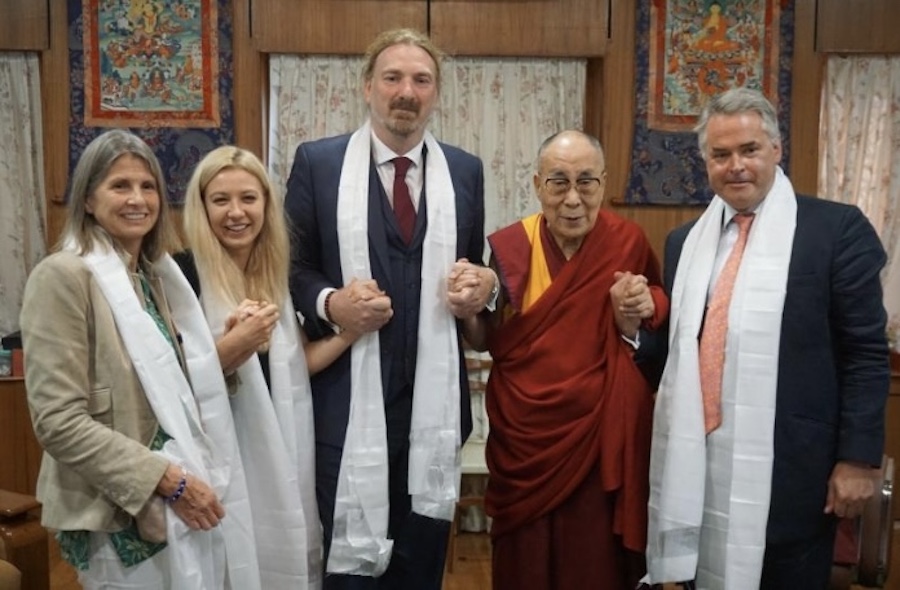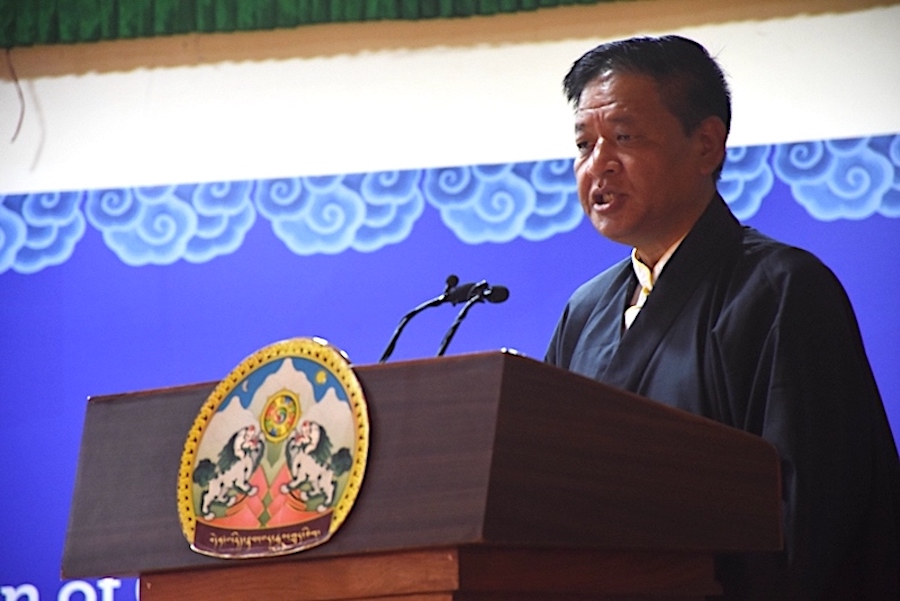By Manik Mehta
While Beijing and New Delhi are hailing improved ties and success in dealing with border issues, Manik Mehta finds that in reality very little has changed on the ground. Take Tibet, for example. India is making no moves to expel the Dalai Lama or his government-in-exile, nor has it completely recognized Chinese claims to the region. In addition, China remains deeply ambivalent about the technological success and democracy in the neighboring giant to the south.
The bonhomie evident between the new Chinese leadership and visiting Indian Prime Minister Atal Behari Vajpayee and his delegation during his recent tour of China could not detract from the fact that relations between the two Asian giants remain under a cloud of suspicion and distrust. Several agreements signed between the two sides, including one on Tibet and Sikkim, were unable to bring the two sides any closer to overcoming their border dispute: India and China fought a brief war in 1962 that has bedeviled relations between them ever since.
The big concessions made by both sides come in the form of an agreement allowing crossborder trade through Sikkim and Tibet, which means China has tacitly acknowledged, as India interprets it, that the northeastern state of Sikkim is part of India, while India has, in return, accepted that Tibet is an undisputed part of China, as the Chinese side harped. These interpretations, however, were provided by the media in the two countries. The official version is that China has not explicitly stated that Sikkim is part of India while India said its position on Tibet has not really changed.
By resorting to such hairsplitting semantics, each side is trying to create a favorable position for itself. Back in the Indian capital, Vajpayee’s sherpas, who organized the summit with the Chinese leadership, have been saying there is absolutely no question of asking the Dalai Lama and his exile government to leave their home in India. They pointed out that the Tibet-Sikkim trade route had to be opened for practical reasons in an attempt to spur crossborder trade, which has an “incredibly huge potential.” India-China trade, a hostage of past poor relations, has risen dramatically in the past decade, soaring from US$330 million in the early 1990s to US$5 billion last year. Experts on both sides predict that trade will increase threefold in the next decade if both sides push it.
Many experts say the agreement does not contain anything new but merely formalizes the status quo. India, for its part, could not have cared less about Sikkim’s status in the eyes of China because, except for an occasional noise made by Beijing, Sikkim is firmly integrated as a state in the Indian union. The entire international community, including Pakistan, which usually jumps to oppose anything benefiting India, has accepted Sikkim as part of India. Even China’s opposition to Sikkim as an integrated part of India was symbolic rather than actively hostile.
The question of Tibet, on the other hand, has been internationalized on several occasions. There are active groups, tacitly encouraged by some governments, which claim that, “Tibet is for the Tibetans.” The “cultural genocide” in Tibet–the local culture and religion have been brutally suppressed as the Han Chinese population is encouraged to migrate to Tibet–has been raised at every available international opportunity to profile Tibet. The Dalai Lama is even welcomed, though without the usual trappings of a state visit, as leader of Tibet, much to the annoyance of the communist regime.
Diplomatic niceties India’s declaration on Tibet, if examined closely, contains certain nuances. Indian diplomats are saying India makes a distinction between the Tibetan autonomous region and the whole of Tibet. The Tibet autonomous region, which lies to the west of the Yangtze River and south of the Kunlun Mountains, is the only area recognized by China as Tibet. Its territory is about a third the size of the old Tibet, which existed before China’s invasion in 1950.
India has also said it will not tolerate “anti-China political activities” by Tibetan exiles living in India. There is nothing new, however, about this declaration. India has always maintained this. Thus, the declaration is merely a repetition of what it has said on previous occasions.
The Dalai Lama’s status in India remains unchanged. India can never expel the Dalai Lama because it would be politically unwise and also extremely inexpedient. It would result in an uproar not only within India but also outside the country. Expelling the Dalai Lama would mean that India would be throwing away any leverage it has against China.
Indeed, it is India that has had a number of grievances against China: the territorial issue of Arunachal Pradesh and Chinese occupation of part of Kashmir, Chinese nuclear and missile sales to Pakistan, tacit encouragement of Pakistan keeping the Kashmir dispute alive and the growing Chinese military presence along the Indo-Myanmar borders to name a few.
Indian democracy worries China Strategic thinkers have long said Beijing is secretly unnerved by the fact that it has on its southern borders a vibrant democracy, which, despite all its imperfections, makes China look like a large prison. China’s 1.3 billion people are controlled by a politburo whose legitimacy is going to be challenged once the population’s current obsession with making money has been realized. The communist bosses have tried to distract the people from politics to continue maintaining their grip over them.
China is, comparatively, a much more prosperous nation than India. Its gross domestic product and per capita income are much higher than those of India. Unlike India, China has over the years built itself a solid industrial base, slowly but surely extending its influence over world markets. Foreign investors, loaded with cash, are too eager to enter China but sulk when it comes to investing in India. This is the finest hour of what has become the world’s factory.
Yet, China looks small in the eyes of the free world when compared with the world’s largest democracy, as India touts itself. Even at the height of the socialist rule of the Congress Party first under Prime Minister Jawaharlal Nehru and, later, his daughter Indira Gandhi, India maintained the hallmarks of democracy: a parliamentary democracy, a free press and a vocally critical opposition.
Technological prowess Despite its growing economic power and strong presence in the international arena, China nurses a certain envy against India which, apart from being democratic, is continuing to open its markets to the outside world. Already, India’s stunning prowess in the field of information technology and its profound global impact have made China realize the potential challenge emanating from its southern neighbor.
By wielding such technological prowess, India has quietly but resolutely created the halo of exclusivity around itself as it emerges as the world’s only software superpower.
This is precisely what makes the communist regime uneasy. This is a major reason why China secretly encourages Pakistan to continue its roguish schemes to destabilize India by resorting to crossborder terrorism over the sticky issue of Kashmir and its Moslem majority in the largely Hindu nation. Using its special relationship with Pakistan, China has carefully nurtured that country as a counterweight to India.
Having practically lost its raison d’etre, Pakistan’s anti-India rationale for existence seems to serve China very well. China is, however, not oblivious to the fact that the Islamic fundamentalism incubated in Pakistan has also reached China, whose Moslem minorities are known to resent communist rule.
But even as China nurtures a more belligerent Pakistan against India, the Chinese leadership should realize that it will invariably push India into a closer military relationship with the United States–a development that is already taking place much to the unease of China.
In addition, the United States has recognized that India can no longer be dismissed as a lightweight. Nuclear tests conducted by India and Pakistan five years ago have resulted in a new constellation in which India plays a greater role on the international stage. Indeed, the nuclear tests seemed to give India the much-needed voice to openly describe China as its “No. 1 enemy” to quote India’s blunt-talking defense minister George Fernandes.
Pakistan India on its part has also recognized that trade and economic ties should not be held hostage to China’s support for Pakistan and the still unsettled border dispute. Both Chinese and Indian businesses are already working with each other in a number of areas, particularly in the area of information technology.
Trade will benefit both China and India in the long run. The late Chinese leader Deng Xiaoping told an Indian delegation, which had visited Beijing to pave the way for former Indian Prime Minister Rajiv Gandhi’s visit to China in 1988, that both sides should put aside the border problem and concentrate on building trust and confidence. This could be done through trade and closer economic cooperation.
India and China have not fully realized the potential of their economic relationship. As trade and business between the two sides grow accompanied by regular technological exchanges, promotion of joint ventures and other economic activities, both sides will be under greater pressure to forge a peaceful relationship.
India is also proposing this approach to Pakistan, whose insistence on first resolving the Kashmir dispute before taking other steps is, however, becoming the main stumbling block to improving ties.
While China has changed its approach to relations with India, there is widespread suspicion among Indians that China will not give up its efforts to encourage Pakistan to keep the Kashmir fire burning because it serves its cause of weakening India by keeping it preoccupied in a perennial, never-ending conflict with Pakistan.









